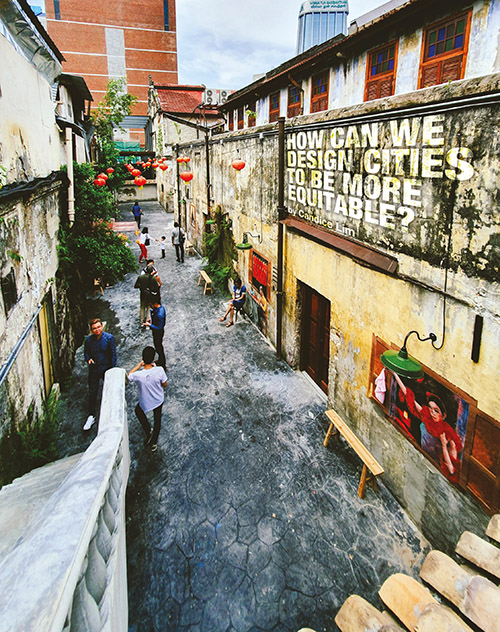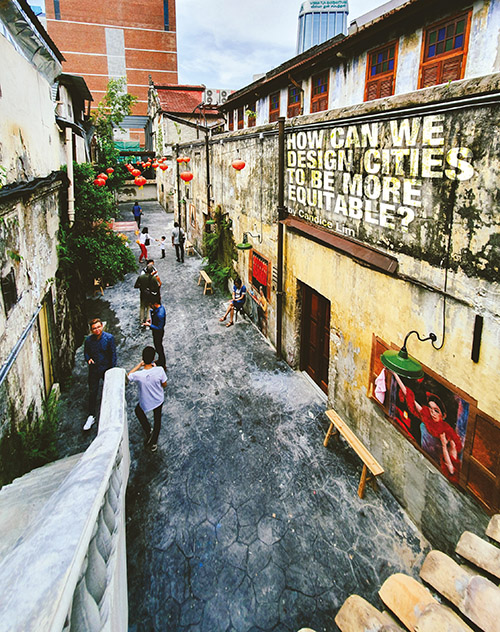How Can We Design Cities to Be More Equitable?
September 24, 2021
When one grows up living in a city-state such as Singapore, one would not have much of an idea of difference between living in a city and outside of it, such as in the suburbs (there’s not much ‘suburbia’ in a small city-state). Thus, living in a city from young does veil one from the presence of inequality, inequity; the existence of marginalised groups, groups in need, or the disadvantaged.
Hence the question of who else exists besides ‘normal folks like us’ seldom comes up (unless if a relative/classmate/friend/ co-worker is from a different socioeconomic or minority group, or is disabled, or somehow ‘different’), let alone whether the marginalised and the needy are being taken care of. Unless of course if and when they come under the spotlight during certain events or occasions, such as charity shows, fundraisers and the like.
As such, we do not often think if the urban spaces that we take for granted on a daily basis are accessible to everyone—can everyone get from point A to point B easily without having private cars; how does everyone get to public areas and facilities; how about access to food, lodging, education, social services, etc?
Do we stop to think if the pavements that we pound on every day are usable for the elderly or handicapped? Who can use the steps in the park? What happens after dark in back lanes? Are there enough green areas in all neighbourhoods? Who gets to use these green spaces?
SO HOW CAN WE DESIGN CITIES TO BE MORE EQUITABLE?
Here, I decided to break it down further into the following key questions and have the experts, with whom we talked to extensively, weigh in:
- What role does infrastructure play in creating more equitable cities?
- How can blue-green infrastructure restore/regenerate cities to increase nature equity?
- How does placemaking come into play towards creating more equitable cities?
- What’s the next step?
[This is an excerpt. Subscribe to the digital edition or hardcopy to read the complete article.]

Dr Yayat Supriatna, MSP
Urban Observer & Lecturer
WHAT ROLE DOES INFRASTRUCTURE PLAY IN CREATING MORE EQUITABLE CITIES?
YS: The gaps in urban infrastructural services between metropolises and smaller cities always exist—resulting in unequal distribution of technology infrastructure and access—because the service system, which is managed by a business entity, focuses on the most profitable and comprehensive areas, in terms of people’s purchasing power. In the case of Indonesia, this gap is noticeably so between services provided in cities on the island of Java and cities outside of Java.
We need to see if the gap arises when the service is merely a business or a service for public interest. Currently, there is no government company that provides full service to the community without taking a business angle. This can actually be done with a subsidy system for a certain period of time or via a non- farebox revenue business model, like how it is done for the transportation business.

Sacha Schwarzkopf
Director, Urban Design Studio, AECOM
HOW CAN BLUE-GREEN INFRASTRUCTURE RESTORE/REGENERATE CITIES TO INCREASE NATURE EQUITY?
SS: Look at the way Surabaya has transformed over the past 10 years. Their downtown area was a vision plan that we had done back in 2011. Their river was treated like a backdoor. Now, you have more parks, more F&B’s along the river way. People are actually boating! So, what has that done? It has told developers to reorient their frontage; you have a frontage on the main street, and we have a whole brand-new frontage on the river. And this starts to capitalise on the market value of those properties to change the perception that this is a great property. So those blue-green initiatives are certainly transformative strategies for cities that are in desperate need of regeneration, or even reinterpretation. You just have to maximise that infrastructure.
RELATED ARTICLE:

Daniel Lim
Placemaking Lead & Senior Programme Manager, Think City
HOW DOES PLACEMAKING COME INTO PLAY TOWARDS CREATING MORE EQUITABLE CITIES?
DL: By improving the public realm in cities, we create more people-friendly and quality public spaces that are connected, inclusive, sustainable and walkable. The heart of this process is the people, always. Working with communities and different stakeholders is key and the idea here is a participatory process of thought. The process in the centre is to discover, because we cannot assume that we know it all. So, through a participatory, community-based process, we ideate together. Thereafter, we prototype a pilot and test it out. If it is proven successful or is the right approach, with further fine-tuning, then it’s ready for a full implementation, replication or to be scaled up.
We also need to stop building trophies. For example, say there is an empty space and someone says “Okay, let’s build a park”. Then it’s all about the design. Again, this needs to be very much about going through the process and finding out what people want. Let’s say I’ve done 20 parks—I go in and create the perfect park; it fits in everything. But what if the communities say “we don’t need a park; we prefer sports like badminton instead, and we don’t have a badminton court”. So maybe that is what the place needs.
RELATED ARTICLE:

Gan Yi Reng
Senior Programme Executive, Think City
HOW DOES PLACEMAKING COME INTO PLAY TOWARDS CREATING MORE EQUITABLE CITIES?
GYR: To understand the site, we did a site analysis, discovered what the issues were and observed how people used it before we engaged any conversation with them. So, during the community engagement processes, instead of inviting them to a hotel ballroom, we went to them to conduct the sessions at one of the cafés near the back lane. So, in this space, we brought the business owners together to find out what issues they were facing, what were the challenges, and how did they use the back lane. We found out mostly they would just close up their back doors and then just left the space be. Based on the engagement sessions, we drew up the list of issues, categorised them into different focus areas and incorporated design responses to address them.
RELATED ARTICLE:
Read more Cities stories below:
To read the complete article, get your hardcopy at our online shop/newsstands/major bookstores; subscribe to FuturArc or download the FuturArc App to read the issues.
Previously Published Main Feature
Contact us at https://www.futurarc.com/contact-us for older commentaries.


